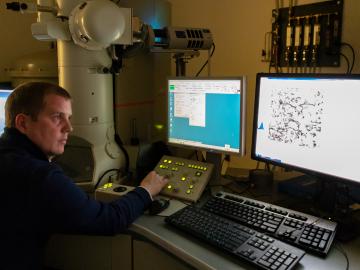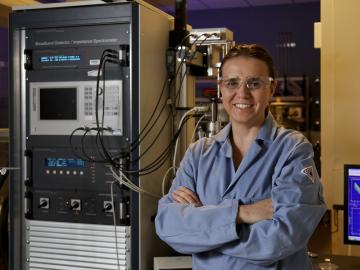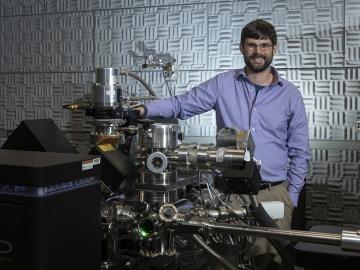
Filter News
Area of Research
- (-) Materials (37)
- (-) Supercomputing (8)
- Advanced Manufacturing (12)
- Biology and Environment (15)
- Building Technologies (1)
- Computational Biology (1)
- Computational Engineering (1)
- Computer Science (2)
- Electricity and Smart Grid (1)
- Energy Science (83)
- Energy Sciences (1)
- Fusion and Fission (1)
- Fusion Energy (3)
- Isotopes (1)
- Materials for Computing (7)
- Mathematics (1)
- National Security (5)
- Neutron Science (5)
- Quantum information Science (1)
- Sensors and Controls (1)
- Transportation Systems (1)
News Type
News Topics
- (-) 3-D Printing/Advanced Manufacturing (6)
- (-) Clean Water (1)
- (-) Composites (4)
- (-) Energy Storage (9)
- (-) Materials Science (25)
- (-) Microscopy (9)
- (-) Summit (6)
- Advanced Reactors (2)
- Artificial Intelligence (1)
- Big Data (5)
- Bioenergy (2)
- Biology (1)
- Biomedical (6)
- Buildings (1)
- Chemical Sciences (6)
- Computer Science (19)
- Coronavirus (3)
- Critical Materials (7)
- Environment (8)
- Exascale Computing (2)
- Frontier (2)
- Fusion (4)
- High-Performance Computing (6)
- Isotopes (2)
- Machine Learning (1)
- Materials (16)
- Molten Salt (1)
- Nanotechnology (12)
- Neutron Science (6)
- Nuclear Energy (6)
- Physics (7)
- Polymers (9)
- Quantum Computing (5)
- Quantum Science (5)
- Simulation (2)
- Space Exploration (2)
- Transportation (7)
Media Contacts

Using Summit, the world’s most powerful supercomputer housed at Oak Ridge National Laboratory, a team led by Argonne National Laboratory ran three of the largest cosmological simulations known to date.

In a step toward advancing small modular nuclear reactor designs, scientists at Oak Ridge National Laboratory have run reactor simulations on ORNL supercomputer Summit with greater-than-expected computational efficiency.

Kevin Field at the Department of Energy’s Oak Ridge National Laboratory synthesizes and scrutinizes materials for nuclear power systems that must perform safely and efficiently over decades of irradiation.

Vera Bocharova at the Department of Energy’s Oak Ridge National Laboratory investigates the structure and dynamics of soft materials.

Scientists have tested a novel heat-shielding graphite foam, originally created at Oak Ridge National Laboratory, at Germany’s Wendelstein 7-X stellarator with promising results for use in plasma-facing components of fusion reactors.

Jon Poplawsky, a materials scientist at the Department of Energy’s Oak Ridge National Laboratory, develops and links advanced characterization techniques that improve our ability to see and understand atomic-scale features of diverse materials

Scientists at Oak Ridge National Laboratory and Hypres, a digital superconductor company, have tested a novel cryogenic, or low-temperature, memory cell circuit design that may boost memory storage while using less energy in future exascale and quantum computing applications.

Oak Ridge National Laboratory scientists studying fuel cells as a potential alternative to internal combustion engines used sophisticated electron microscopy to investigate the benefits of replacing high-cost platinum with a lower cost, carbon-nitrogen-manganese-based catalyst.

An Oak Ridge National Laboratory-led team used a scanning transmission electron microscope to selectively position single atoms below a crystal’s surface for the first time.

Sergei Kalinin of the Department of Energy’s Oak Ridge National Laboratory knows that seeing something is not the same as understanding it. As director of ORNL’s Institute for Functional Imaging of Materials, he convenes experts in microscopy and computing to gain scientific insigh...


